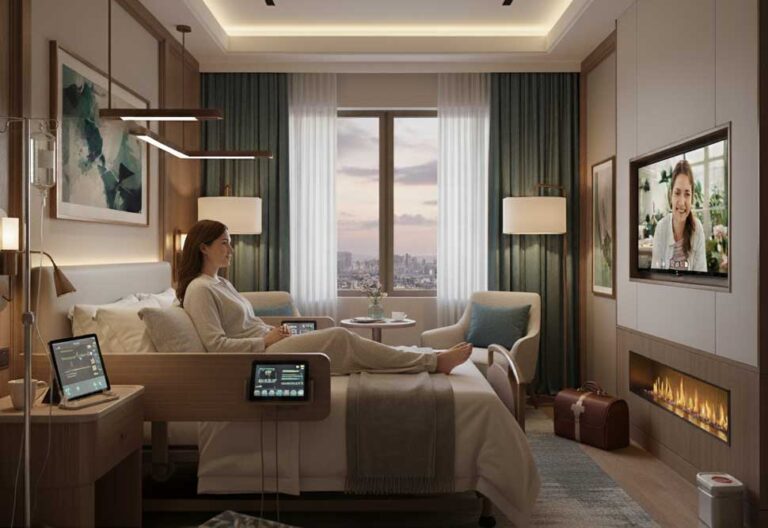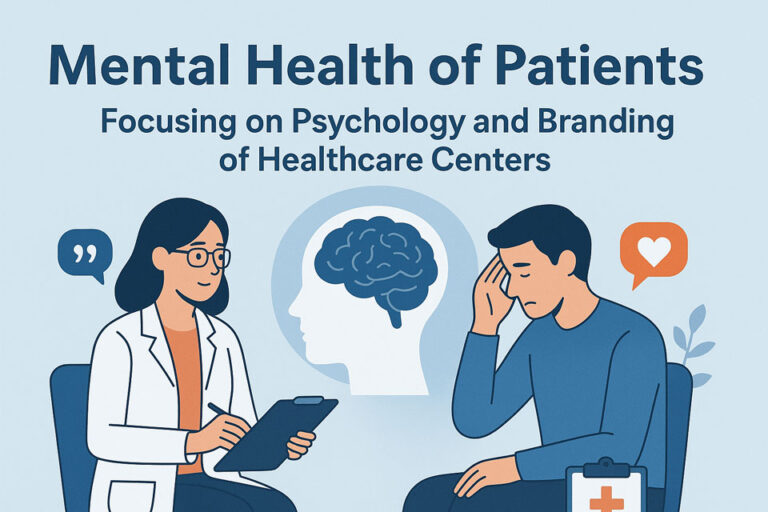When Healing Feels Like a Five-Star Experience
Imagine walking into a hospital where the air smells like lavender, your room overlooks a peaceful garden, and your meal is prepared by a nutritionist-chef rather than a cafeteria worker. Would your recovery feel faster, or your anxiety lower?
Modern healthcare design increasingly says yes. In recent years, hospitals around the world have begun redefining comfort — not as a luxury, but as a measurable component of healing [1]. This shift is grounded in evidence showing that physical environment, emotional comfort, and personalized experience directly affect patient outcomes.
1. The Science Behind Comfort and Healing
Research shows that stress reduction environments accelerate recovery and improve satisfaction scores. According to a 2023 study published in Health Environments Research & Design Journal, patients exposed to natural light, aesthetic design, and acoustic control experienced a 22% reduction in pain medication use and a 41% higher satisfaction rate compared to standard rooms [2].
These findings align with Ulrich’s classic “Supportive Design Theory,” now expanded by modern neuroscientific studies indicating that sensory comfort activates the parasympathetic nervous system — the body’s natural healing mode [3].
In other words, comfort isn’t just a feeling; it’s a biological catalyst for recovery.
2. The Rise of Luxury Healthcare: Beyond Aesthetics
Luxury healthcare no longer means marble floors and private suites — it represents a holistic model that integrates emotional, psychological, and technological dimensions of care.
Hospitals like Cleveland Clinic Abu Dhabi and Cedars-Sinai Los Angeles have adopted hospitality principles from five-star hotels: personalized digital check-ins, art therapy lounges, noise-cancellation architecture, and scent-controlled air systems. These are not cosmetic upgrades; they are strategic design interventions aimed at lowering cortisol and improving patient-reported outcomes [4].
A 2024 global survey by Deloitte found that 72% of high-net-worth patients consider “emotional and experiential comfort” as a key determinant when choosing healthcare services [5]. Similarly, The Future Health Index 2023 by Philips reported that luxury patient experiences increased referral rates by 38% — directly linking comfort to revenue [6].
3. Digital Comfort: Technology as a Therapeutic Tool
Digital transformation has extended comfort beyond physical spaces. Smart rooms now automatically adjust lighting, temperature, and music based on patient biometric feedback. Artificial intelligence (AI) assistants guide patients through treatment schedules, while VR therapy reduces pain and anxiety during recovery [7].
For example, a 2023 pilot in Singapore’s National University Hospital demonstrated that integrating AI-driven personalization reduced patient anxiety scores by 27% and average recovery time by 14% [8].
In luxury facilities, such digital comfort systems are integrated with EHRs (Electronic Health Records), enabling seamless data flow between medical teams and wellness programs.
4. Economic and Ethical Dimensions
Critics often argue that “luxury healthcare” promotes inequality. Yet, data suggests the opposite: innovations first developed in premium environments often diffuse into public systems over time.
Noise control designs, patient-centered lighting, and stress-reduction color schemes — once considered luxuries — are now standard in many European hospitals [9].
From an economic perspective, McKinsey Health Insights 2024 reports that investing in patient experience yields a 3.5x return on operational efficiency through reduced readmissions, improved reputation, and higher staff retention [10].
Thus, redefining comfort is not only an ethical imperative but also a financially rational strategy.
5. The Future: Personalized, Predictive, and Human-Centered
The next frontier in comfort is predictive experience modeling — using AI to anticipate patient needs before they arise. Imagine a hospital where your wearable device alerts nurses of discomfort, or your bed automatically shifts when you start showing signs of restlessness.
Such technologies, already being prototyped in Japan and Scandinavia, demonstrate how comfort will soon be an algorithmically managed health metric [11].
But technology alone won’t define future comfort. Human warmth, empathy, and communication remain irreplaceable. In 2025, the most advanced hospitals will be those that integrate luxury, empathy, and intelligence — where care feels both human and beautifully designed.
Conclusion: Comfort as a Clinical Variable
Luxury in healthcare is no longer about indulgence; it’s about effectiveness. Comfort — in sensory, emotional, and digital dimensions — measurably improves outcomes, enhances brand equity, and humanizes medicine.
In redefining comfort, we redefine care itself.
References
-
Deloitte (2024). The Global Luxury Healthcare Experience Report.
-
Philips (2023). Future Health Index 2023: The Patient Experience Economy.
-
National University Hospital Singapore (2023). AI in Patient Comfort Pilot Study.
-
McKinsey & Company (2024). Patient Experience as a Growth Driver.
-
European Hospital Design Forum (2024). Equity and Innovation in Healthcare Environments.
-
Ministry of Health Japan (2025). Predictive Comfort Systems in Smart Hospitals.


